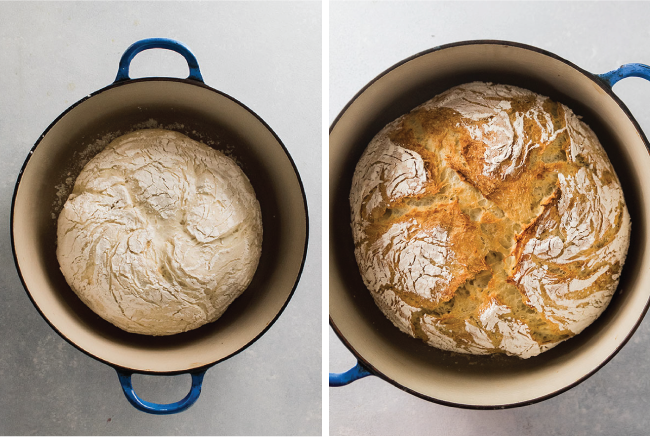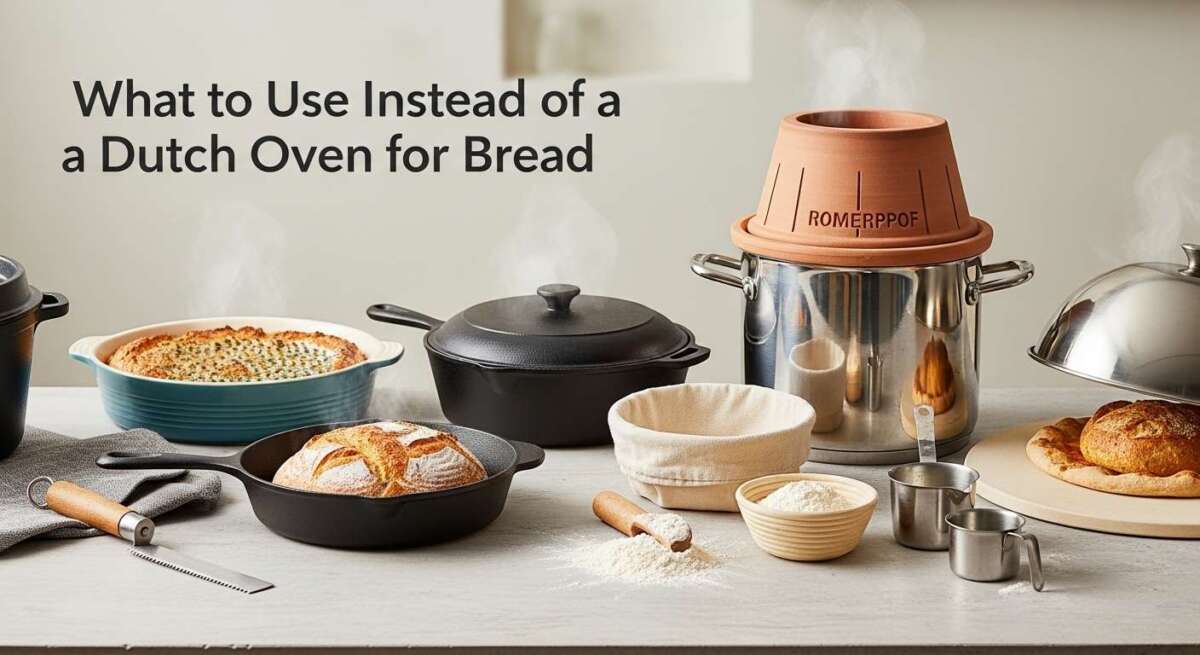If you’re passionate about baking bread but find yourself without a Dutch oven, you’re not alone. Many aspiring bakers share this challenge, and the good news is you don’t need to feel stuck.
There are plenty of alternatives that can help you achieve that perfect crust and soft interior. Imagine the aroma of freshly baked bread wafting through your kitchen, a testament to the ingenuity of using what you have at hand. You’re about to discover creative solutions that will enable you to bake delicious bread without the need for a Dutch oven.
Keep reading, because the secret to mouthwatering homemade bread is just a few lines away.

Credit: www.youtube.com
Cast Iron Skillet
Choosing a cast iron skillet for bread baking is smart. It offers even heat distribution, which is crucial for perfect bread. Skillets can create a crispy crust similar to a Dutch oven. They are versatile and easy to use.
Many home bakers use skillets for their simplicity. They are durable and last for years with proper care. If you want a convenient alternative to a Dutch oven, consider a cast iron skillet.
Benefits Of Using A Skillet
A skillet heats evenly, ensuring consistent baking results. It can handle high temperatures, making it ideal for bread. The skillet’s surface provides a natural non-stick property.
This feature helps in easy bread removal after baking. Skillets are versatile, allowing you to bake various bread types. They are also easy to clean and maintain.
Tips For Baking Bread
Preheat your skillet before placing the dough. This helps achieve a crispy crust. Use parchment paper to prevent sticking. Cover the skillet with foil to trap steam.
Steam is essential for soft bread interiors. Monitor the baking time closely. Every oven heats differently, so adjust accordingly. Allow the bread to cool before slicing.
Clay Pot
Clay pots offer a practical alternative for baking bread without a Dutch oven. Their heat-retaining properties create a perfect environment for crusty loaves. Simply preheat the pot, place the dough inside, and enjoy delicious homemade bread.
When you think of baking bread, a Dutch oven might be the first tool that comes to mind. Its ability to trap steam and ensure even heat distribution is unmatched. But what if you don’t have one? Enter the clay pot, an age-old alternative that offers a unique twist to your bread-baking adventures. Clay pots are often overlooked but can be a fantastic substitute, bringing their own benefits to the table. Have you ever wondered how a clay pot could mimic a Dutch oven’s capabilities? Let’s dive into this intriguing option.
How Clay Pots Mimic Dutch Ovens
Clay pots can closely replicate the conditions of a Dutch oven. They have a natural ability to retain moisture, ensuring your bread stays soft inside while developing a crispy crust. Their porous nature allows for steam circulation during baking, creating an ideal environment for your dough to rise beautifully. You might be surprised at how efficiently a clay pot can maintain steady heat, just like its cast iron counterpart. It’s fascinating to think that a simple clay pot, with its earthy appeal, could elevate your bread-making game. So, why not give it a shot?
Preparation And Maintenance
Before using a clay pot, it’s crucial to soak it in water for about 15 minutes. This step primes the pot to release steam during baking, enhancing your bread’s texture. Once you’re done baking, clean the clay pot with warm water and a soft brush. Avoid soap, as it can seep into the clay and affect future flavors. Regularly check for cracks or chips, as these can impact heat retention and moisture release. With proper care, your clay pot will serve you well for many delicious loaves to come.
Bread Cloche
Baking bread at home often requires specific tools. A bread cloche can serve as an excellent alternative to a Dutch oven. It is designed to create the perfect environment for baking bread. Its unique shape helps trap steam, improving crust quality. Discover how a bread cloche can enhance your baking experience.
Design And Function
The bread cloche is crafted from ceramic. This material helps distribute heat evenly. The dome shape traps moisture inside. This feature is key for achieving a crispy crust. It mimics the environment of a brick oven. The base is flat for easy loading and unloading.
Using a cloche, bread bakes evenly. Its design ensures consistent results. The ceramic retains heat well. Your bread gets a golden color and perfect texture. It’s an ideal tool for home bakers.
Effective Baking Techniques
Preheat the cloche for best results. This prepares the surface for baking. Place your dough on the base. Cover it with the dome before placing in the oven. Steam will be trapped inside. This technique enhances the crust of your bread.
Keep an eye on baking time. A cloche may require less time than a Dutch oven. Check your bread’s color and texture. Adjust time based on your observations. Practice leads to great results.
Remember, the cloche impacts moisture levels. Adjust your recipe if needed. More water can be added to the dough. Experiment with hydration levels. Perfect your technique over time.
Pizza Stone With Bowl
Baking bread without a Dutch oven can be challenging. A pizza stone with a bowl offers a great alternative. This method mimics the environment of a Dutch oven. It provides the heat retention and steam needed for perfect bread.
Creating A Steaming Environment
The key to good bread is steam. Steam helps create a crusty exterior. To achieve this, place a bowl over the dough. The bowl traps steam, creating a moist atmosphere. This helps the bread rise and crust evenly.
Choose a bowl that can handle high temperatures. Metal or ceramic bowls work well. Ensure it covers the dough completely. The bowl should not touch the dough. Leave space for the bread to expand.
Best Practices For Use
Preheat the pizza stone in your oven. A hot stone ensures even heat distribution. Place the dough directly on the stone. Cover it with the bowl. This setup mimics a professional oven.
Use parchment paper to prevent sticking. It makes transferring dough easier. Carefully remove the bowl halfway through baking. This allows the crust to brown. Check the bread’s color and texture regularly.
Cleaning the stone is simple. Avoid soap as it can leave residue. Use a dry brush or cloth. Regular maintenance keeps your pizza stone in top shape.
Stainless Steel Pot
Consider using a stainless steel pot to bake bread when a Dutch oven is unavailable. Its heat distribution ensures even cooking, helping create a crispy crust. Make sure it has a tight-fitting lid to trap steam, mimicking the Dutch oven’s environment.
Are you a bread enthusiast looking to try something new? If you don’t have a Dutch oven, a stainless steel pot might be your next best friend. Not only can it deliver delicious results, but it also brings its own unique advantages to your baking process. Let’s dive into how you can use a stainless steel pot to bake bread that’s just as good, if not better, than what you’d make in a Dutch oven.
Advantages Of Steel Pots
Stainless steel pots are incredibly versatile. They’re lightweight compared to cast iron, making them easier to handle, especially when transferring your dough in and out of the oven. Have you ever found yourself struggling with the weight of a Dutch oven? A stainless steel pot can save you from that hassle. They also heat up quickly and retain heat efficiently. This means your bread can rise evenly and get a nice crust. Some people even claim that the quicker heat-up time leads to a more flavorful bread. Have you ever considered that a lighter pot could change the taste of your bread?
Bread Baking Techniques
Using a stainless steel pot requires a few adjustments. First, preheat your pot along with the oven. This helps to mimic the environment of a Dutch oven and ensures your dough has a hot surface to hit when it’s ready to bake. Try covering your pot with a tight-fitting lid or foil to trap steam. This helps to create the same effect as the heavy lid of a Dutch oven, allowing your bread to expand and develop a perfect crust. Ever noticed how steam can transform your bread’s texture?
Lastly, experiment with different placements in the oven. Some bakers find that placing the pot on a baking stone or sheet can further enhance the crust. Who knew that a simple adjustment could make your bread even better? So, next time you’re in the mood to bake bread, grab your stainless steel pot. You might just discover a new favorite baking tool. Have you tried baking bread with a stainless steel pot yet?
Stock Pot
A stock pot serves as a great alternative to a Dutch oven for baking bread. Its large size and sturdy construction help retain heat, creating a crispy crust and soft interior. Just ensure it’s oven-safe to handle high temperatures.
Baking bread at home can be a rewarding experience, but not everyone has a Dutch oven on hand. A surprising alternative? The stock pot. Often overlooked, this kitchen staple can serve as a fantastic substitute for bread baking. With a few tweaks, you can transform your stock pot into a bread-baking champion.
Why Stock Pots Work
Stock pots are more than just soup vessels. They are designed to hold large volumes and distribute heat evenly, which is crucial for baking bread. Their thick walls help maintain a consistent temperature, ensuring your bread bakes evenly. Have you ever wondered why bread in a Dutch oven turns out so well? It’s the steam that gets trapped inside, creating a crunchy crust. Stock pots can mimic this environment effectively. Most come with tight-fitting lids that help retain steam, giving you that sought-after crusty texture.
Adapting For Bread Baking
To use a stock pot for bread, consider its size. Choose one that allows enough room for your bread to rise without touching the sides. This gives the dough space to expand, resulting in a well-shaped loaf. Preheat your stock pot in the oven just like you would with a Dutch oven. The preheating step is essential. It helps in forming a crusty outer layer while the inside remains soft and chewy. If you’re worried about your bread sticking, line the pot with parchment paper.
This simple step can save you a lot of frustration when trying to remove your baked loaf. Have you tried using a stock pot for baking bread? Experimenting with different kitchen tools can open up new possibilities. You might find that your stock pot becomes your new favorite bread-baking ally. Don’t let the lack of a Dutch oven hold you back from baking delicious homemade bread. Dive into your kitchen and explore the potential of your trusty stock pot. You might just surprise yourself with the results.
Casserole Dish
When baking bread without a Dutch oven, a casserole dish can be a wonderful alternative. It’s a common kitchen item, which makes it accessible for most people. You might be surprised at how well it can replicate the results of a Dutch oven when used correctly.
Using Lids And Foil
One way to use a casserole dish effectively is by utilizing its lid. A tight-fitting lid can help trap steam, mimicking the environment of a Dutch oven. This steam is crucial for giving your bread that delightful, crispy crust.
If your casserole dish doesn’t come with a lid, you can use aluminum foil as a substitute. Wrap it tightly around the top of the dish to ensure minimal steam escapes. Have you ever tried this simple hack and noticed the difference in your bread’s texture?
Achieving The Right Crust
Crust is king when it comes to homemade bread. To get it just right with a casserole dish, preheating is key. Pop your dish in the oven as it warms up, allowing it to reach the desired baking temperature.
Consider adding a small tray of water at the bottom of the oven. This technique increases humidity, enhancing the crust’s texture. Experiment with these methods and see how they transform your baking experience!
Have you ever thought about how the tools you use impact your bread’s outcome? A simple switch from a Dutch oven to a casserole dish might be all you need to elevate your baking game. Try it next time and share your results!

Credit: www.lifeasastrawberry.com
Glass Bakeware
Glass bakeware is a handy alternative for baking bread. It offers a clear view of your dough’s progress. This transparency helps monitor browning and crust formation. Glass is easily available and affordable, making it a popular choice for home bakers.
Heat Retention Properties
Glass bakeware retains heat well. This ensures a consistent baking temperature. It absorbs heat slowly but holds it longer. This feature allows for even cooking. Your bread will have a uniform texture. The crust can develop a nice golden brown hue.
Bread Baking Adjustments
Baking bread in glass requires some adjustments. Preheat the bakeware to get optimal results. This helps in achieving a crispy crust. Use parchment paper to prevent sticking. Reduce baking temperature slightly. Glass holds heat longer, preventing over-browning.
Consider covering the bread halfway through. This prevents the top from browning too quickly. Always cool the bread on a wire rack. It prevents moisture buildup under the loaf. Glass bakeware offers a different baking experience. Adapt your techniques for the best results.
Frequently Asked Questions
What Can Replace A Dutch Oven For Bread?
You can use a heavy-duty cast iron skillet with a lid or a Pyrex dish. These alternatives can mimic the steam and heat retention of a Dutch oven. Ensure the lid fits tightly to trap steam and create the perfect crust for your bread.
Is A Covered Casserole Dish Suitable For Bread?
Yes, a covered casserole dish is a good alternative. It retains heat well, creating steam similar to a Dutch oven. Ensure it’s oven-safe and has a tight-fitting lid. This setup helps achieve a crispy crust while keeping the inside soft and airy.
Can I Bake Bread In A Cast Iron Skillet?
Yes, you can use a cast iron skillet for baking bread. Cover it with aluminum foil or a metal bowl to trap steam. Preheat the skillet for even heat distribution, which helps in achieving a crispy crust and soft interior.
Is Using A Baking Stone Effective For Bread?
A baking stone is effective for making bread. It provides even heat distribution and a crispy crust. Preheat the stone thoroughly before placing the dough on it. For steam, place a pan of water on the oven’s lower rack.
Conclusion
Exploring alternatives to a Dutch oven for bread is simple. Many kitchen tools work well. Cast iron skillets and baking stones are great options. They help achieve a crispy crust. Even a simple baking sheet can work. Experiment with covered pots or casserole dishes too.
Each tool offers unique benefits. Try different methods and find your favorite. Baking bread can be fun and rewarding. No need for fancy equipment. Just use what you have at home. Enjoy the process and fresh, homemade bread. Happy baking!


Leave a Reply